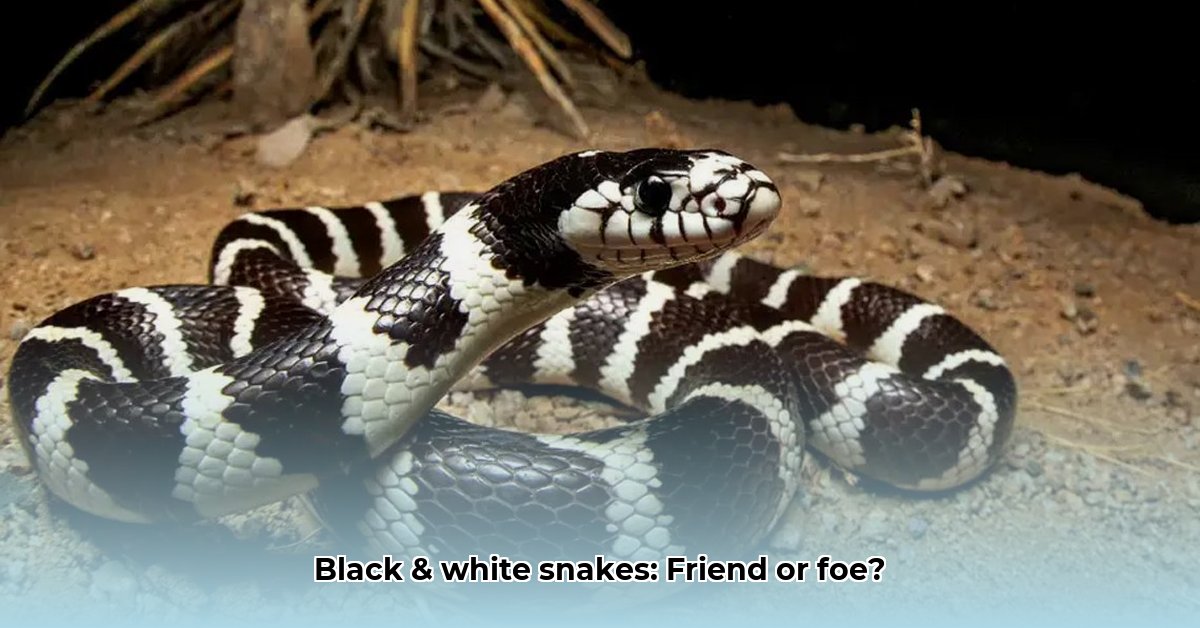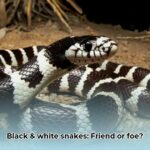Understanding the difference between venomous and non-venomous snakes is crucial, especially when encountering those with striking black and white patterns. This guide delves into the world of these fascinating reptiles, exploring identification techniques, diverse habitats, intricate defensive mechanisms, and essential safety precautions. For example, the Sonoran gopher snake is often mistaken for a venomous species.
Decoding the Patterns: Venomous or Harmless?
Identifying black and white snakes requires a multifaceted approach that extends beyond simply observing their coloration. Several key characteristics can help distinguish between species, enabling more accurate identification.
Head Shape
Venomous snakes, such as pit vipers, often possess triangular heads due to the presence of venom glands. Non-venomous snakes typically exhibit rounder heads. However, some non-venomous snakes can flatten their heads when threatened, mimicking the appearance of venomous species as a defense mechanism.
Pupils
The shape of a snake’s pupils can also offer valuable clues. Pit vipers often have vertical, elliptical pupils, while non-venomous snakes generally have round pupils. However, exceptions exist, like certain venomous coral snakes with round pupils. This emphasizes the importance of considering multiple identification factors.
Scales
Examining the scales under the tail, known as subcaudals, can provide further insight. Many venomous snakes in North America have a single row of subcaudal scales, whereas non-venomous snakes often have two rows.
Geographic Location
The location where a snake is encountered plays a critical role in identification. A species that is harmless in one region may have a venomous counterpart in another. Consulting regional field guides is essential for accurate identification based on geographic location.
Patterns and Markings
The specific arrangement of black and white markings – whether stripes, bands, speckles, or blotches – can be indicative of particular species. The width, shape, and placement of these markings should be carefully observed and compared to reliable identification resources.
Habitats and Ecological Roles: A Global Perspective
Black and white snakes inhabit a wide range of environments worldwide, from arid deserts to lush rainforests. Their distribution is influenced by factors such as temperature, humidity, prey availability, and the presence of suitable shelter. Their ecological roles are equally diverse. Some species are ambush predators, while others actively hunt their prey. They play vital roles in their respective ecosystems by regulating prey populations and serving as a food source for other animals. Understanding their dietary preferences, which can include rodents, reptiles, amphibians, and eggs, is essential for comprehending their ecological impact.
Defensive Strategies: Camouflage, Mimicry, and More
The black and white patterns exhibited by these snakes often serve as effective camouflage, allowing them to blend seamlessly into their surroundings. This adaptation is beneficial for both hunting and evading predators. Some harmless species employ Batesian mimicry, imitating the appearance of venomous snakes to deter potential threats. Many snakes also utilize defensive behaviors such as hissing, vibrating their tails, flattening their heads, or releasing musk to ward off predators.
Conservation Concerns: Protecting Vulnerable Species
Many snake populations face threats from habitat loss, human-wildlife conflict, and the illegal pet trade. Conservation initiatives are vital for safeguarding these reptiles and preserving the delicate balance of their ecosystems. Understanding the specific threats faced by different species is crucial for implementing effective conservation strategies.
Safety First: Responsible Observation
When encountering any snake, prioritizing safety is paramount. Never attempt to handle an unknown snake, regardless of its appearance. Observe from a safe distance using binoculars or a camera with a zoom lens. If bitten by any snake, seek immediate medical attention, even if the species is believed to be non-venomous. Learning to identify venomous snakes in your region and understanding their behavior is essential for minimizing risks and fostering coexistence. By appreciating these remarkable creatures from afar, we can contribute to their conservation and ensure our own well-being.
- Unlock Water’s Symbolism: A Cross-Cultural Exploration - April 20, 2025
- Identify Black and White Snakes: Venomous or Harmless? - April 20, 2025
- Unlocking Potential: Origins High School’s NYC Story - April 20, 2025















